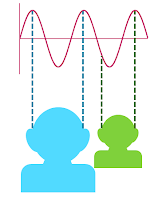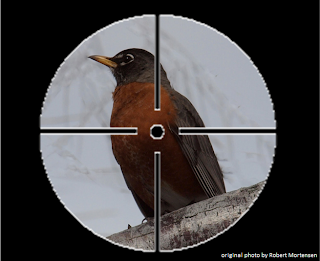As an avid birder as well as a student at BSU, I always love it when something I
learn at school relates to my birding addiction. Last semester, when taking a
class called “sensory ecology” I got the chance to hear a lot of things about
birds that I could apply to birdwatching, so I’ve
decided to make this subject the topic for my next few blog posts. So, what
follows is a bit more sciency than birdy, but I hope you guys will stick with
me through this post, and I will try my best to make it make sense!
How are Robins such
good ventriloquists??
Maybe you’ve heard this before (or maybe you haven’t) but a
few times when I’ve been out birding with someone and we come upon a flock of
robins, we remark on how they seem to be able to “throw” their voices. You can
be looking at a few birds sitting together in the top of a tree, and when they
make those high pitched calls, it sounds as if they are coming from a
completely different place. (listen to an
example of the high pitch calls here,
time 0:04-0:40). That’s not just a figment of your imagination; in a way, robins actually are able to throw their voices. Here's my take on these concepts based on the little I learned from my Sensory Ecology class. (granted not all these ideas have been tested scientifically, and some of this is just based on my own knowledge of how auditory systems work in general)
We all know that birds have a variety of vocalizations. Of course
there are the songs that most people think of, but then there’s the wide range
of calls, each with a different function that is adapted for use in different
situations. The particular high pitched call of a robin (and many other birds,
such as sparrows, chickadees, Golden-crowned Kinglets, or waxwings) is a
communication call meant for reaching other members of the flock.
 But of course there’s a problem, because any sound a bird makes has the potential to be intercepted by an unintended
recipient (like a sharp shinned hawk for example)….so how can robins and
other birds communicate to their flock-mates without also alerting a predator
to their presence? They take
advantage of certain properties of sound to avoid detection. Birds
communicate with high-pitched calls for a reason.
But of course there’s a problem, because any sound a bird makes has the potential to be intercepted by an unintended
recipient (like a sharp shinned hawk for example)….so how can robins and
other birds communicate to their flock-mates without also alerting a predator
to their presence? They take
advantage of certain properties of sound to avoid detection. Birds
communicate with high-pitched calls for a reason.
First of all, their high-pitched
calls don’t carry very far in the environment…high frequency sound
attenuates more quickly, especially in vegetated habitats (so the call won’t
reach that sharpie perched a few hundred feet away). Second, many raptors have the best hearing at low frequencies (to pick up rustling noises) but are not able to hear as well as you reach higher frequencies. And third, it is possible that these calls are more difficult to locate even if they are heard, especially for mammals with big heads….let me explain.
When we hear a sound,
humans use a combination of many methods to localize it. Just like using crosshairs
to find a target (or a coordinate graph, if we want to flash back to 8th
grade math class), we need to find where the sound is in the horizontal plane (was
that sound from the left or the right?) as well as the vertical plane (was that
sound above or below me?) in order to exactly locate it. Mammals use different
techniques to find each piece of the crosshair.
When either a bird or a human hears a sound, its brain uses
what is referred to as “binaural phase comparison” to help calculate where that
sound is coming from on the horizontal plane. Basically, the brain looks at how the sound waves
entered each ear, and figures out which ear received the sound first….if
the left ear received the sound first, then the sound was on the left, and vice
versa. Here’s where we humans run into a problem. (Check out the figure below
to understand this a little better)
 When a bird with a small head hears a high frequency noise,
the sound wave hits each ear in a completely different way….the wave may be
curving down when it hits the left ear, and “up” when it hits the right ear, so
it is easy for the brain to tell which ear received the sound first. However,
when a big-headed human hears the same frequency, the wave may be curving in
the exact same way when it reaches both ears, making it seem like the wave hit
both ears at the same time, so that it
is very difficult to tell where the sound came from.
When a bird with a small head hears a high frequency noise,
the sound wave hits each ear in a completely different way….the wave may be
curving down when it hits the left ear, and “up” when it hits the right ear, so
it is easy for the brain to tell which ear received the sound first. However,
when a big-headed human hears the same frequency, the wave may be curving in
the exact same way when it reaches both ears, making it seem like the wave hit
both ears at the same time, so that it
is very difficult to tell where the sound came from.
Not only do our big heads prevent us from locating a robin
alarm call, but the fact that we are mammals also messes us up! We are different from birds in this way because we have these funny
looking external ears. Those strange
curves and spirals in our ears are actually there to help us localize sound in the
vertical
plane. When a certain frequency hits our external ear, it bounces off at a few different places...this tells our brain that the sound could have
come from a number of possible locations. When
a sound has many frequencies, each frequency reflects a little differently,
giving us multiple clues to the sound’s actual location. Using these
multiple frequencies, our brain uses “binaural spectral comparison” to
calculate where the sound came from in the vertical plane.
If this doesn’t
really make sense, check out the picture below: When a bird sings, its song
often has multiple frequencies (in this example the song has three). Let’s say
one frequency tells us that the bird could be in any of three different
locations (the blue circles), then a second frequency tells our brain that the
bird could be in three more possible locations (the red squares), and so on…our
brain can use all these cues to calculate where the sound is coming from
because there is only one location where
all three frequencies intersect.
But what happens when the sound has only one frequency? Mammals run into a
problem, and here’s where robin
ventriloquism comes in. Unlike its song, a robin’s high-pitched call is not
composed of so many frequencies. So when birders are looking at the robin and
we hear it call, our brain can’t calculate which location is the right one,
making it seem like the robin can throw its voice.
So, now that we know this, how can it help us as birders?
Well, first off it can maybe help us not feel crazy when we swear we heard the Golden-crowned Kinglet from that branch right there….it’s actually just as likely the kinglet has used its
anti-predator adaptations to fool us!
We can also use some
of our own adaptations to help us
localize high-pitched bird calls better. See, while high frequency sounds
don’t work so well for binaural phase comparisons, our big heads can actually help us out when we are trying to locate a
sound, because we have a second method for determining a sound's location in horizontal plane: High frequency sounds have small wavelengths that are too short to
travel around our heads. Instead, they hit our head, and create a “sound
shadow” on the other side….this means that if a sound comes from the left it
will seem loud in our left ear and much quieter in our right ear. By turning your head slightly sideways from
where you think the bird is, you can create a sound shadow which will help
you tell which side the bird is on.
Well, there you go! The first of my Sensory Ecology blog
posts. I hope you guys enjoyed learning about the science behind some common birding
conundrums!






Interesting Stuff!
ReplyDeleteVery interesting post - love this kind of thing. cheers and Happy New Year.
ReplyDeletedan
Very interesting info. Thanks!
ReplyDeleteHappy New Year to the Birding is Fun clan!
Robert, sometimes you amaze me! How do you know all this stuff? Very interesting post and a lot to think about as I go out birding in 2012! Happy New Year to You!
ReplyDeleteFascinating. Sure explains some things I've encountered in the field. Very interesting post!
ReplyDeleteKathie, I wish I could take credit, but this post was from Heidi Ware, a fantastic and enthusiastic birder and grad student at Boise State who also works at the Idaho Bird Observatory.
ReplyDeleteGreat post, Heidi! Makes perfect sense of my recent experience of trying to locate a sparrow in dense thickets on both sides of a trail - repeated high frequency low amplitude calls very close by but was never able to figure out where the sparrow was actually at. Won't feel so stupid next time around.
ReplyDeleteThats fascinating Heidi! I knew that high-frequency sounds were more difficult to locate than lower frequency ones, but your post has turned it into a very interesting subject!
ReplyDelete